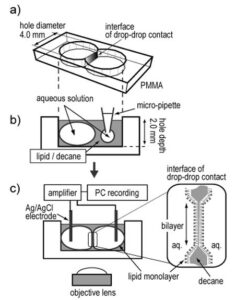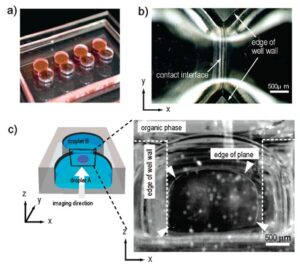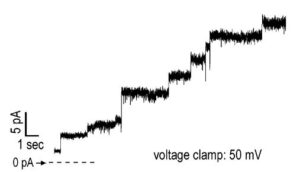2006: Easy method of making a planar lipid bilayer by contacting two droplets.
“Lipid Bilayer Formation by Contacting Monolayers in a Microfluidic Device for Membrane Protein Analysis”
Published in Kei Funakoshi, Hiroaki Suzuki, and Shoji Takeuchi, Anal. Chem. 2006, 78, 24, 8169–8174.
Artificial planar lipid bilayers are a powerful tool for the functional study of membrane proteins, yet they have not been widely used due to their low stability and reproducibility. This paper describes an accessible method to form a planar lipid bilayer, simply by contacting two monolayers assembled at the interface between water and organic solvent in a microfluidic chip. The membrane of an organic solvent containing phospholipids at the interface was confirmed to be a bilayer by the capacitance measurement and by measuring the ion channel signal from reconstituted antibiotic peptides. We present two different designs for bilayer formation. One equips two circular wells connected, in which the water/solvent/water interface was formed by simply injecting a water droplet into each well. Another equips the cross-shaped microfluidic channel. In the latter design, formation of the interface at the sectional area was controlled by external syringe pumps. Both methods are extremely simple and reproducible, especially in microdevices, and will lead to automation and multiple bilayer formation for the high-throughput screening of membrane transport in physiological and pharmaceutical studies.







